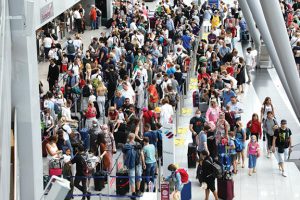Much of the rich world is emerging from two years of pandemic more flush than it’s ever been. Deposits held by consumers at US commercial banks are roughly $3.5 trillion above where they’d have been if they continued the pre-pandemic trend, a position that inflation is only starting to eat away.
For the airline industry, it’s precisely the opposite. While travel volumes are returning to something like normality in most of the world, the legacy of Covid — in the form of the vast debts clocked up during two years on life support — has barely shifted. If you’re looking for an explanation for the chaotic scenes of cancelled flights, lost baggage and passenger number caps at airports this northern hemisphere summer, it’s worth considering the drastic cost-cutting the industry will be undergoing for many years to come.
Airlines would dearly love to tempt passengers back with the promise of a return to business as usual. The stubbornly persistent debts they’re holding make that almost impossible.
Net borrowings by more than 100 airlines globally for which Bloomberg has data were running at a combined $377.85 billion in their latest reports, more than a third higher than $281.03 billion at the same time in 2019 — and that was already a rough year for the aviation industry, thanks to rising costs and trade tensions. Compared to 2018, debts have doubled.
While traffic volumes are starting to recover, profits are not. Earnings before interest, tax, depreciation and amortization over the past 12 months across the industry amounted to $25.77 billion — an improvement on the $45.98 billion ebitda loss a year earlier, but barely more than a third of typical levels going into the pandemic. The relationship between those two figures is a decent benchmark for a company’s ability to service its debts. Right now it’s a flashing red emergency sign.
Banks start to get worried when their corporate borrowers have debts amounting to more than three or four times their ebitda. That number went to 4.7 this time two years ago, before heading off the charts last year when ebitda turned negative. This year, it’s worse than it was in 2020, at 14.7 — almost unimaginable levels for any solvent company, let alone an entire industry. Of 113 companies for which Bloomberg has the relevant data, just 23 are able to meet their interest payments out of earnings before interest and tax.
Those numbers may well get worse before they get better. Jet fuel prices, which typically make up 20% to 30% of costs for airlines, are about 50% above their 2019 levels, at $132.31 a barrel in Singapore. Last month, they hit an all-time high of $164.30. Although net debt levels are down marginally since peaking midway through last year, the cost of servicing those loans has also ballooned as interest rates have climbed. On a very rough estimate taken from the yield on 10-year US government bonds, airlines’ interest bill this year is almost double what it was 12 months ago, despite an 8.4% reduction in borrowings.
Investors have taken notice. The Bloomberg World Airlines Index has been trending down ever since. It’s currently at levels comparable to the darkest months of the pandemic.
 The Gulf Time Newspaper One of the finest business newspapers in the UAE brought to you by our professional writers and editors.
The Gulf Time Newspaper One of the finest business newspapers in the UAE brought to you by our professional writers and editors.
